
Bron is a commune in the Metropolis of Lyon, Auvergne-Rhône-Alpes region, eastern France.

Lyon also spelled in English as Lyons, is the third-largest city and second-largest metropolitan area of France. It is located at the confluence of the rivers Rhône and Saône, 391 km (243 mi) southeast of Paris, 278 km (173 mi) north of Marseille, 113 km (70 mi) southwest of Geneva, and 50 km (31 mi) northeast of Saint-Étienne.
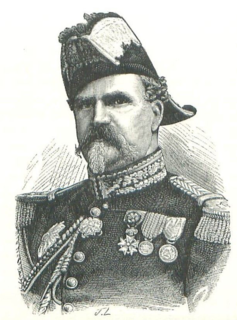
General Baron Hubert Rohault de Fleury was a French soldier who played a major role in the fortifications of Lyon.

The Séré de Rivières system was named after Raymond Adolphe Séré de Rivières, its originator. The system was an ensemble of fortifications built from 1874 along the frontiers and coasts of France. The fortresses were obsolescent by 1914 but were used during the First World War.

The Fortifications of Vauban is a UNESCO World Heritage Site made up of 12 groups of fortified buildings and sites along the borders of France. They were designed by renowned military architect Sébastien Le Prestre de Vauban (1633–1707) during the reign of King Louis XIV. These sites include a variety of fortifications, ranging from citadels, to mountain batteries and sea fortifications, to bastion walls and towers. In addition, the site includes cities built from scratch by Vauban and communication towers. These sites were chosen because they exemplify Vauban's work, bearing witness to the influence of his designs on military and civilian engineering on a global scale from the 17th century to the 20th century.
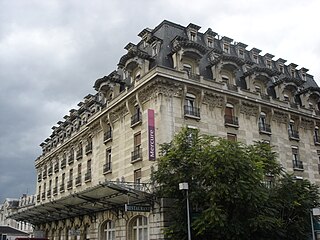
The Hôtel Mercure Lyon Centre Château Perrache, originally Hôtel Terminus, then Pullman Perrache, then Château Perrache, is a hotel of the AccorHotels group built in 1906. It is located on cours de Verdun in the 2nd arrondissement of Lyon. The hotel was used as the headquarters for the Gestapo in Lyon during the Second World War. It is the eponym of the Marcel Ophüls film Hôtel Terminus: The Life and Times of Klaus Barbie about the Gestapo in Lyon.
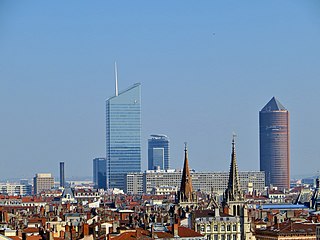
La Part-Dieu is the Central Business District (CBD) and beating heart of Lyon Metropolis, inside an urban area of more than 2.2 million inhabitants. It is also the second largest tertiary district in France, after La Défense in Greater Paris, with over 1,150,000 m2 of office and service space, along with 45,000 service sector jobs, 2,500 companies, affordable rents and a 97% occupancy rate. A major European nerve centre, La Part-Dieu high-speed train station is a leading interchange rail station on the continent, welcoming 120,000 travellers everyday, while its multimodal hub deals with 500,000 daily commuters, by means of public transport such as métro, tram and bus lines, taxi and bike services, including the Rhônexpress shuttle connecting La Part-Dieu directly with Lyon-Saint-Exupéry International Airport.

The fortified region of Belfort(place fortifiée de Belfort) formed the first line of defense in the Séré de Rivières system of fortifications in the Belfort Gap. Located in northeastern France between Épinal and Besançon, the primary line was built in the late 19th century to deal with advances in artillery that had made older defensive systems obsolete.

Montluc prison is a former prison located on rue Jeanne Hachette in the 3rd arrondissement of Lyon, France. It was known for being an internment, torture and killing place by the Gestapo during the occupation of France by the Nazis.

The Fort des Ayvelles, also known as the Fort Dubois-Crancé, is a fortification near the French communes of Villers-Semeuse and Les Ayvelles in the Ardennes, just to the south of Charleville-Mézières. As part of the Séré de Rivières system of fortifications, the fort was planned as part of a new ring of forts replacing the older citadel of Mézières with dispersed fortifications. With advances in the range and destructive power of artillery, the city's defensive perimeter had to be pushed away from the city center to the limits of artillery range. The Fort des Ayvelles was the only such fortification to be completed of the ensemble, as resources were diverted elsewhere. At the time of its construction the fort controlled the Meuse and the railway line linking Reims, Montmédy, Givet and Hirson. The Fort des Ayvelles was reduced in status in 1899, its masonry construction rendered obsolete by the advent of high-explosive artillery shells. However, it was re-manned for the First World War before it was captured by the Germans on 29 August 1914. The fort was partly destroyed in 1918. During the Battle of France in 1940 the fort was bombarded. French resisters were executed at Ayvelles during both world wars. At present the fort is maintained by a preservation society, and may be visited.

The Fort du Télégraphe, or Fort Berwick, is located in the Maurienne valley on the road to the Col du Galibier between Valloire and Saint-Michel-de-Maurienne, at the Col du Télégraphe, dominating the valley of the Arc. The location at an altitude of 1,585 metres (5,200 ft) previously accommodated a telegraph of the Chappe system using articulating arms to send messages between Lyon and Milan, and after 1809, Venice. The fort has two entrances with drawbridges to allow access to different levels of the fort, with inclined ramps to allow easy movement of artillery pieces. When completed in 1884 after four years of construction, the fort was manned by 170 men, firing four artillery pieces at the main fort and four more at detached batteries.

Santa Cruz Fort is one of the three forts in Oran, the second largest port city of Algeria; the other two forts are Fort de la Moune at the western end of the port and Fort Saint-Philippe, a replacement of the old castle of the Saints known in Spanish as Castillo de los Santos, at the centre of Oran. The three forts are connected by tunnels. Fort Santa Cruz was built between 1577 and 1604 by the Spaniards on the Pic d’Aidour above Gulf of Oran in the Mediterranean Sea, at an elevation of above 400 metres (1,312 ft). In 1831, the French occupied Oran and the fort.
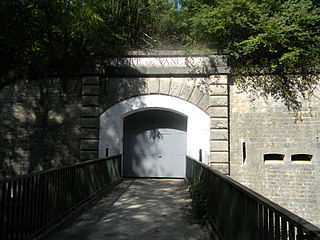
The Fort de Vancia is a former military installation built between 1872 and 1878 in the municipalities of Sathonay-Village and Rillieux-la-Pape, north of Lyon. It is part of the second belt Lyon and more generally the system Sere de Rivieres. This belt of forts included the forts of Bron, Vancia itself, Feyzin and Mont Verdun.

The Fort d'Aubervilliers is a former fortification of Paris built for 1842 to 1846 in Aubervilliers to control the "route de Flandre", now Route nationale 2, to the northeast of Paris. The Fort d'Aubervilliers is part of the first ring of Paris fortifications outside the old city walls built by Adolphe Thiers in the 1840s to defend the capital against invasion and to control the city's rebellions.

The Fort de Bron is a fortification built between 1875 and 1877, located in the commune of Bron. It is part of the second belt of fortifications around Lyon, which also includes Fort de Vancia, Fort de Feyzin and Fort du Mont Verdun.

The Fort Feyzin is a fort built between 1875 and 1877 in Feyzin. It is one of the forts of the second belt of forts around Lyon and more generally the Séré de Rivières fort system. This belt of forts included the forts of Bron, Vancia, Feyzin and Mont Verdun. It currently houses a riding stable managed by the UCPA on behalf of the city of Feyzin.

Fort de Caluire was an old fortification situated in Caluire-et-Cuire. Now demolished, it was part of the first belt of forts protecting Lyon.
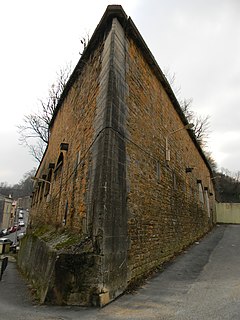
Fort de Loyasse is a fort built between 1836 and 1840. It is currently in the 9th arrondissement of Lyon and is part of the first belt of forts protecting Lyon.

The Fort de Montessuy is a fort in the first belt of fortifications in Lyon, located in the neighborhood of Montessuy in Caluire-et-Cuire, Rhône, France.

The ceintures de Lyon were a series of fortifications built between 1830 and 1890 around the city of Lyon, France, to protect the city from foreign invasion.





















